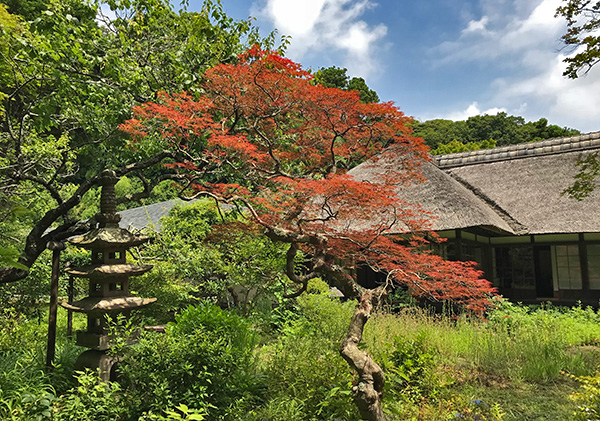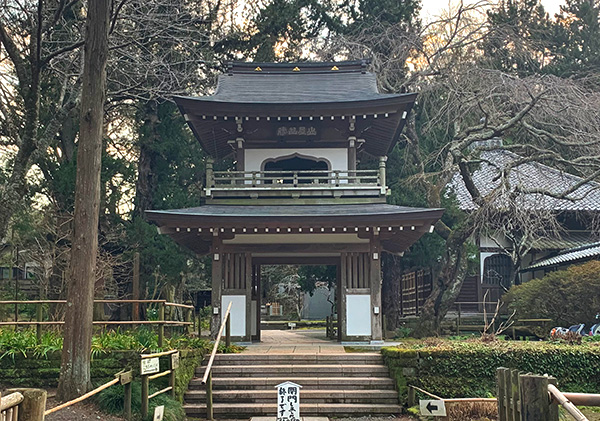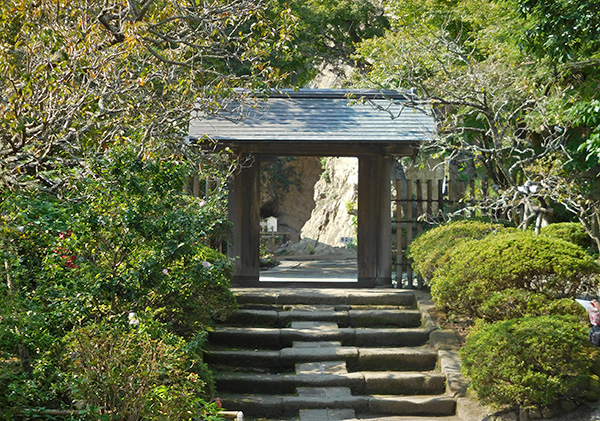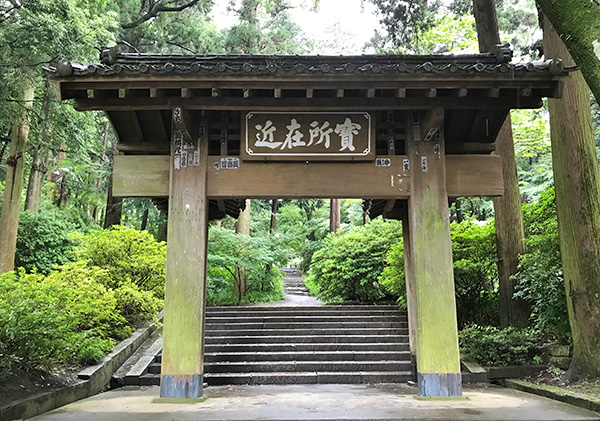Jochiji
| Official Name | Kinpozan Jochiji {Pronounced kin-poh-zan joe-che-gee} |
|---|---|
| Religious sect | Engakuji school, Zen (Rinzai) Sect, Buddhism |
| Founded | in 1283 Mrs. Munemasa Hojo {moo-neh-mah-sah hoh-joe} and Morotoki {moh-roh-toh-key} Hojo |
| Founding priest | Funei Gottan {foo-nay gott-an}, Shonen Taikyu {sho-nen tye-kyu} and Kokai Nanshu {koh-kye nan-shoe} |
| Main object of worship | Statues of Shaka {shah-kah}, Miroku {me-roh-koo} and Amida Nyorai {ah-me-dah nyo-rye} |
| Address | 1402 Yamanouchi, Kamakura, Kanagawa 247-0062 (show route from current location ) |
| Location | 250-meter south of Kita-Kamakura Station |
| Time needed to get there | 8 minutes |
| Admission | JPY300 |
| Open | 9:00 - 16:30 |
| Phone number | 0467-22-3943 |
| Restrooms | Available |
Historical Overview
The Temple ranks fourth on the list of Five Great Zen Temples in Kamakura. When Munemasa Hojo (1254-1283), the third son of Fifth Hojo Regent Tokiyori, died young at the age of 29, his wife and their son Morotoki (1275-1311) (later he assumed the post of the Tenth Regent), jointly established the Temple to pray for the repose of the departed soul, invitingPriest Funei Gottan (1197-1276) as the first chief priest. Usually, one priest was enough to be the founding priest. In this temple, however, three are listed. According to several literatures, the real founding priest was Priest Kokai Nanshu (?-1303), but he thought he was too young to be given the honorary position and, asked the founders that Priest Gottan as well as Priest Taikyu (1215-1289) , both Chinese and came to Japan at the request of Fifth Regent Tokiyori Hojo, be nominated as the founding priests. When the Temple construction was completed, however, Priest Gottan had already passed away.
Tokimune {toh-key-mo-neh} Hojo (1251-1284), the Eighth Regent, must have also helped build the Temple in the face of the untimely death of his younger brother. Mrs. Munemasa Hojo was another contributor, though little information about her is available in this male-dominated society and era.
At its peak, the Temple had 11-structures including the main hall and sub-temples, and nearly 500 people lived in the temple precinct. In the memorial service held for the Ninth Regent Sadatoki Hojo (1271-1311)'s 12th anniversary of death at Engakuji in 1323, it is recorded, more than 200 priests of Jochiji joined the service. Inside the Temple's grounds today, however, there is no old buildings. The main hall Donge-den {don-geh-den} and other structures we see today were built after the Great Kanto Earthquake of 1923.

Kanro-no-i {kan-ro-no-e} well
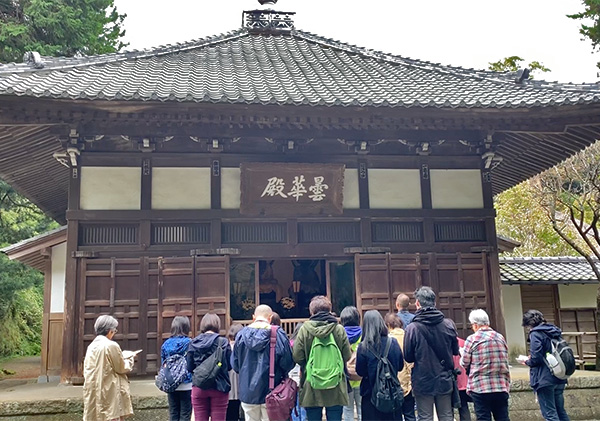
At the entrance, there is a well, called "Kanro", said to be one of the Ten Celebrated Wells in Kamakura and its water was once one of the five best. Kanro is literally sweet dew in Japanese, or amrta in Sanskrit meaning sweet dew heavenly gods drinks and shed to the earth when people are happy with the ruler. Today's well is, however, far from celebrated. It's like a small pond and muddy. The photo shows amateur photographers surrounding the well to take pictures. The stone steps leading to the main hall is well-worn and tell us how the Temple is old.
Belltower-cum-Gate
Unique is the two-story main gate with a bell on the second floor. No other temples in Kamakura have this kind of structures. The shape of windows appearing on four walls looks like a bell and is called Kato-mado {kah-toh-mah-doh} (mado means a window in Japanese), which was originally employed by Zen temples to show a lotus flower. The bell was cast in 1340, according to the inscription affixed to it. The top of the roof tiles is emblazed with the crest of the Hojos.
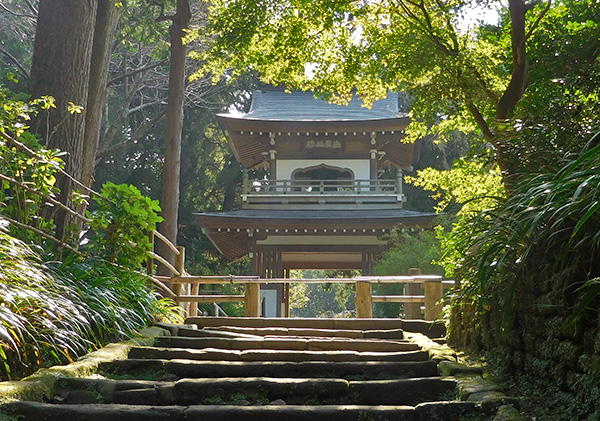
Donge-den or the Main Hall
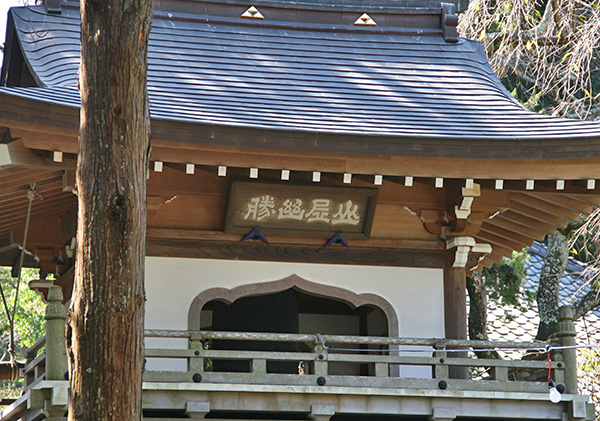
In the 7.2-meter-square Donge-den hall, three wooden statues of Nyorai {nyo-rye} (Tathagata in Skt.) are enthroned on the central altar as the main objects of worship: From your left to right, Amida (Amitabha in Skt.), Shaka (Sakyamuni in Skt.) and Miroku (Maitreya in Skt.), all in seated figures and represent "past", "present" and "future" Nyorai respectively. The statue of Shaka is believed to have been fashioned circa 1370. The other two were carved in the mid-15th century. Wavy pattern of the skirt, of which hem is draping down, is the apparent features of Sung style in China. All are Important Cultural Assets designated by Prefectural Government of Kanagawa.
On the left-hand side of the threesome statues is another statue of Priest Daruma {dah-roo-mah} (Bodhidharma in Skt.), the founder of Chinese Zen Buddhism in the sixth century. The wooden statue was made in the 14th or 15th century. In Priest Daruma's portraits we often see, he almost always has a bushy-beard face with piercing eyes. Daruma dolls sold in Japan are like basket cases. But the statue here has no beards and looks even beaming.
